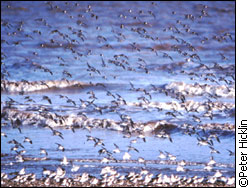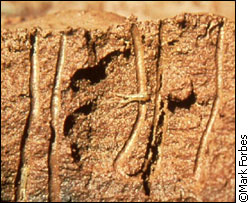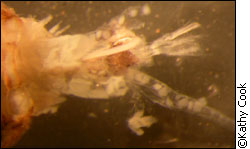| Sex
change artists
of the Bay of Fundy
By Travis Webb
OTTAWA —
This shrimp has traveled a
long way. She was born and
raised on the mudflats of the Bay of Fundy – an
inlet off the Atlantic enclosed by the coast of Nova
Scotia and New Brunswick.
 |
| They may be small, but Corophium
play a pivotal role in the the Bay of Fundy. |
Last summer, the tiny shrimp – she’s
no larger than a dime – made the 900 km journey
to Ottawa.
Now, she spends her time in a bar fridge
that sits on a lab bench in Carleton University’s
Nesbitt Building. She lies there quietly, waiting for
her big day.
When they’re ready for her, she’ll
be whisked onto a sterile, brightly-lit operating surface.
Moments later, the procedure will begin.
They want her ovaries.
“It’s a lot of work,”
says Mark Forbes, the Carleton biologist responsible
for the shrimp’s ordeal.
But it’s work with a purpose.
After all, these shrimp may hold a key
to the survival of one of Canada’s most important
ecosystems.
More than mud
From the highway, Peter Hicklin says the
Bay of Fundy mudflats look pretty barren. Wet deserts,
he calls them.
But walk out onto a flat and he says it’s
a different story.
| '(The sandpipers)
double their weight . . . and use that fat to fly
4,000 km non-stop down to South America.' |
“It’s like standing in a bowl
of Rice Krispies,” says Hicklin, a research scientist
with the Canadian Wildlife Service in New Brunswick.
“You hear snap, crackle, pop . . . It’s
alive.”
Much of that life is Forbes’ shrimp,
Corophium volutator. By mid-summer, Hicklin
says the mudflats swell with more than seven billion
of them.
With these incredible numbers come great
responsibility: The shrimp work the pumps at one of
the biggest gas stations in the world.
Each summer, two or three million Semipalmated
Sandpipers descend upon the mudflats to fuel up. The
bay is their only stop on their trip from the Arctic
to Brazil, says Hicklin, who has studied the birds for
more than 20 years.
“The sandpipers feed almost exclusively
on Corophium,” says Forbes. “They
double their weight . . . and use that fat to fly 4,000
kilometres non-stop down to South America.”
Take the shrimp out of Fundy and the birds
could be facing a serious fuel crisis.
 |
| Mudflats like the one in
Johnson's Mills, N.B. are home to millions of sandpipers
every summer. |
But serving the sandpipers is only the
most dramatic example of Corophium’s
importance to Fundy. According to Hicklin, the shrimp
help provide nutrients for Right whales living in the
bay. Forbes says 15 species of intertidal fish rely
on Corophium as a food source.
Research even suggests the burrows the
shrimp dig help keep the mudflats – and the habitat
they provide for other organisms – from washing
away.
“Corophium is so central
to the food web that we call it a key species,”
says Forbes. “If they were to go (extinct), it
could have some very severe ecological consequences.”
It’s a threat Forbes says isn’t
that far-fetched. Corophium populations in
Europe have collapsed in the past and Forbes says Fundy
has experienced some small localized crashes in recent
years.
“(Corophium populations)
blink on and off,” he says. “(My lab) is
interested in trying to figure out what the factors
are and determine whether parasites are one of them.”
Parasites enter the picture
Forbes is a parasitologist. By definition,
he says a parasite lives in or on another organism.
Having established a home, the parasite uses its host
to derive its own nutrient requirements. In the process,
it causes some degree of harm to its gracious provider.
But Forbes is interested in more than
just these individual effects. Instead, he explores
ecological parasitology – the study of how parasites
affect the distribution and abundance of organisms in
an ecosystem.
 |
| Much of Forbes' research
focuses on species which hold ecological or economic
importance. |
Over the course of his career, Forbes
has worked with several species including dragonflies
and frogs. He says most of the hosts he studies hold
some sort of economic or ecological importance.
His work with Corophium in the
Bay of Fundy is no different.
Still, Robert Poulin, a parasitologist
at the University of Otago in New Zealand, says the
European Corophium extinctions show the reach
of Forbes’ research.
“Corophium and their close
relatives are hugely abundant in intertidal mudflats
all over the world,” says Poulin. “(Forbes’)
work has potential implications that extend beyond the
Bay of Fundy.”
| 'Corophium
populations blink on and off . . . (My lab) is interested
in trying to figure out what the factors are and
determine whether parasites are one of them.' |
David Marcogliese, a parasitologist with
Environment Canada, agrees. He also says much of Forbes’
research – including his Corophium studies
– can be applied to more general host-parasite
relationships.
“(Forbes’ work) is conceptually
and theoretically interesting,” says Marcogliese.
“He’s not just going out there and measuring
things. In that sense, his work is quite novel and progressive.”
But for now, Forbes says he’s not
focused on these peripheral benefits.
He just wants to wrap his head around
the Corophium dating scene.
Battle of the sexes
Corophium males have it pretty
good.
They’re surrounded by enormous numbers
of friends and family – sometimes as many as 60,000
of them per square meter.
Better yet, most of the company is female.
 |
| During mating season,
Corophium males investigate neighbouring burrows
searching for females. |
Depending on the location, Forbes says
there are anywhere from four to 12 females for every
male. While this might sound good for the guys, it presents
a potentially serious problem.
“If you have too few females, the
population may not grow as quickly,” says Forbes.
“We may get so many females that males are actually
limiting and (Corophium) can have these localized
crashes.”
In this limiting scenario, Corophium
males aren’t able to fertilize enough females
to sustain the population. An added complication, says
Forbes, is that Corophium mate on a lunar cycle.
Males only get one chance a month to meet as many females
as they can.
It’s a situation akin to asking
one mailman to complete 12 routes all in one shift.
Some female shrimp will get their delivery, but by the
end of the day, many will be left staring disappointedly
into an empty mailbox.
With so many potential mothers ignored,
population crashes in Fundy become a possibility.
Forbes turned to his specialty for an
explanation.
The idea isn’t without precedence.
Marcogliese says research out of England has shown that
a certain parasite alters the sex ratio of another species
of crustacean.
“There’s all kinds of interesting
things going on with (feminizing) parasites,”
says Marcogliese. “They can have profound impacts
on populations of organisms.”
But could this be happening in Corophium?
“Oh, it’s quite possible,”
says Marcogliese.
So Forbes and his lab – specifically
post-doc Selma Mautner – set out to harvest shrimp
from Fundy last summer. Back in Ottawa, the team began
cutting open Corophium and removing ovaries
from females and testes from males.
'It’s
quite different from anything we know about .
. . This parasite is new to science.' |
It’s a delicate process, but it
allows them to extract and identify the DNA contained
in the sex organs of the shrimp. If an invading parasite
is present, its genetic code will show up in the DNA
analysis.
“We found a parasite that is found
only in the ovaries of Corophium females,”
says Forbes.
Early returns
In the initial group of 37 Corophium
males , none carried a parasite in their testes. Meanwhile,
a parasite was detected in the ovaries of seven of the
25 females.
“We believe the parasite feminizes
(male Corophium) and continues its life cycle
by being passed on in daughters, granddaughters, and
great granddaughters,” says Forbes.
According to Forbes, the parasite can
only survive in the nutrient-rich ovaries of Corophium
females. When the female’s eggs are fertilized,
the parasite sees an opportunity to pass on its own
offspring.
But if the parasite’s progeny enters
an egg destined to become male, it panics. It can’t
live in that environment. As the young Corophium
grows, the parasite flips the shrimp’s gender.
A genetic male develops into a female.
 |
| Corophium ovaries
provide ideal accomodation for Forbes' microscopic
parasite. |
Forbes says the parasite may perform this
trick by altering hormone secretions at a sensitive
stage of development. But this theory is pure guesswork
– the parasite is too small to study at Carleton.
As a result, Forbes says he knows little
about details like what harm the parasite brings its
Corophium host. To learn more, the team sends
samples of the parasite to England, where they are examined
under a scanning electron microscope.
For now, Forbes and his team must satisfy
themselves with what the DNA sequence of the parasite
tells them.
“It’s quite different from
anything we know about,” he says. “This
parasite is new to science.”
According to Forbes, the DNA sequence
also indicates the parasite belongs to a group of single-celled
parasites called the Microsporidia. Given its genetic
similarity to these parasites, one can get a picture
of how Forbes’ parasite may operate in Corophium.
For example, Microsporidian parasites
reproduce by ejecting spores. When a spore encounters
a host cell that appeals to them, it pricks the cell
with a needle-like tube and the parasite is injected
inside.
This is likely how Forbes’ parasite
reproduces.
But these details aren’t Forbes’
immediate concern. Instead, he and his team want to
document the presence of the parasite in the most female-biased
populations in Fundy. Collecting this data would be
a first step towards definitively attributing skewed
sex ratios to the parasite.
If this is established, it may be possible
to link the parasite to population crashes among Corophium.
So far, he says the numbers indicate as much.
“We’ve actually seen evidence
of a population crash and as far as we know, (the parasite)
is more prevalent there than anywhere else we’ve
seen yet,” he says.
| 'It’s possible
this micro parasite is driving the whole system.' |
Forbes says they have yet to find a skewed
population the parasite hasn’t infected. At the
same time, however, he hasn’t been able to find
a population with a one-to-one sex ratio.
Discovering such a population would help
Forbes test his theory. If the parasite hadn’t
infected these Corophium, it would add weight
to the idea that the parasite feminizes the shrimp and
threatens their numbers.
Positive parasitism?
Dean McCurdy, a researcher at Albion College
in Michigan and a collaborator with Forbes on the Corophium
Project, says the parasite may not be a threat at all.
He says by feminizing shrimp, the parasite may actually
facilitate Corophium’s enormous population.
“If you (have) nine females and
one male that can fertilize all of them . . . than all
of the females produce offspring,” he says.
With an equal ratio, five males have to
compete for five females. Consider that five factories
can’t produce as much as nine factories, assuming
they have the staff to operate them.
Similarly, nine Corophium females
can produce more offspring than five.
“It’s possible this micro
parasite is driving the whole system,” says McCurdy.
Forbes says it’s a possibility but
adds it would only work at low levels of infection.
Still, these are the kinds of effects
Forbes wants to explain. While his project isn’t
there quite yet, Robert Poulin says Forbes’ work
should provide a richer understanding of Corophium
and feminizing parasites.
“There are still many important
questions to be asked about these parasites,”
he says. “I’m certain Forbes’ work
will take some original directions.”
 |
| The Bay of Fundy mudflats
would be dramatically different without Corophium.
|
Meanwhile, Peter Hicklin says parasites
aren’t a serious threat to Corophium
populations. A more immediate concern, he says, is human-influenced
changes in sedimentation rates in the Bay of Fundy.
According to Hicklin, these changes may be re-shaping
the shrimp’s habitat.
Regardless, Hicklin says any Corophium
research is worthwhile.
“I have great respect for that little
creature,” he says. “The more work is done
on them, the more we can appreciate the (need for) its
conservation.”
In the end, Forbes says there wouldn’t
be much he could do if there was a population crash
in the near-future.
Instead, he says a Corophium
collapse may actually provide a good opportunity for
further research into the tiny shrimp holding the Fundy
food web together.
“(We want to be) at least somewhat
prepared for documenting the effects of those crashes,”
he says. “We want to be Johnny-on-the-spot if
they do occur.”
|